
Earthquakes
Defining Earthquakes
Originate with sudden shifting of rock
When rocks are under significant pressure, and this pressure continues to build until it exceeds the strength of the rocks, they break and shift, releasing the built-up pressure
This released energy travels outward from the point of breakage and travels in a wave-like motion
On the ground surface, the wave of motion is felt as the ground shaking, or an earthquake
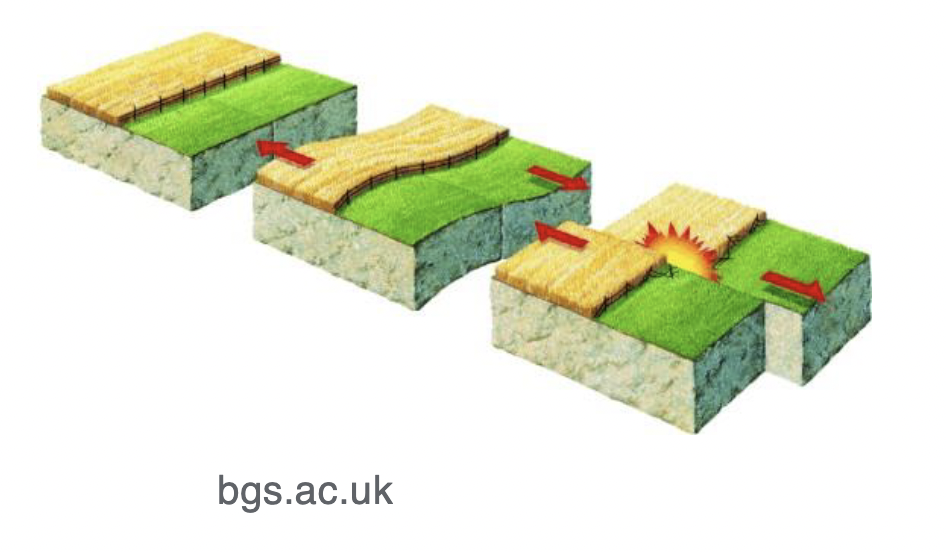
This process is also known as elastic rebound
Elastic rebound: when the rocks release pressure, they rebound to their undistorted (though now broken) condition
The breaking and shifting of rocks results in the creation of faults
Fault: a crack in the rocks along which there has been some kind of movement of the rocks
A crack is only a fault of the rocks have shifted along the fault
Faults may shift vertically or horizontally
The continuous vertical shifting of rocks along faults can produce significant mountain ranges
Eg. the Teton Mountains of Wyoming
Every movement of rocks along a fault produces an earthquake; bigger shifts tend to produce bigger earthquakes
Most earthquakes originate from fault shifts; most fault shifts occur underground
The point where the fault moves (the point from which the earthquake originates) is called the focus
The point on the ground surface, directly above the focus, is called the epicenter
This is marked on most maps as the geographic location of earthquakes

The energy originates from the focus and travels outward in all directions with wavelike motions
Seismic waves: the waves of energy traveling through the surrounding rocks
There are multiple kinds of seismic waves
Surface wave: a seismic wave that travels on the ground surface
Sometimes have visible vertical movements in intense earthquakes

Body wave: a seismic wave that travels through the earth
Two main types of body waves are p- and s-waves (primary and secondary)
P-wave: a body wave that travels by compressing and stretching the rocks in a push/pull motion

S-wave: a body wave that travels through a shaking motion (vertical or horizontal)
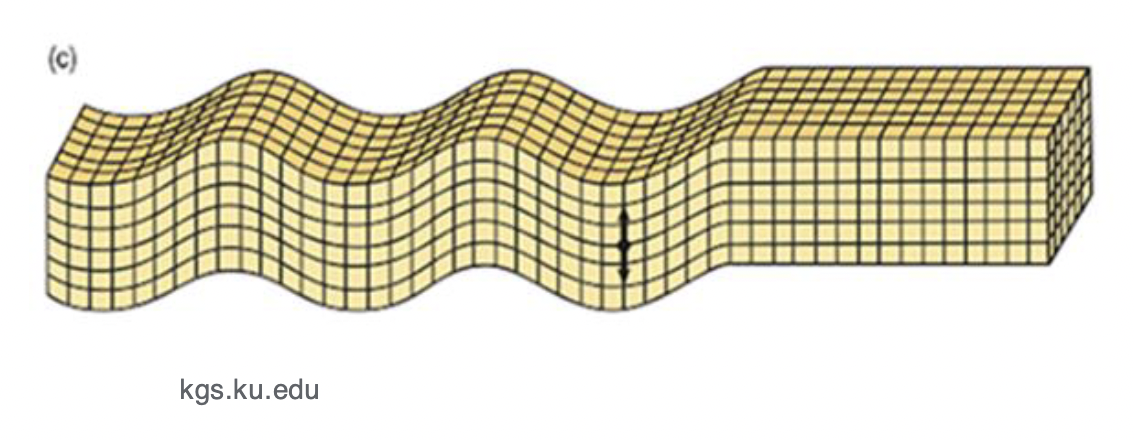
P-waves travel faster than s-waves
Earthquakes may also result from the movement of magma rising under a volcano
Rocks shift, having been deformed by the rising magma and release built-up energy
Measuring Earthquakes
Seismology: the study of earthquakes
Seismologist: a geologist who studies earthquakes
Seismograph: a device used to measure the intensity of earthquakes
A simple scientific device based on physics (specifically the principle of inertia)
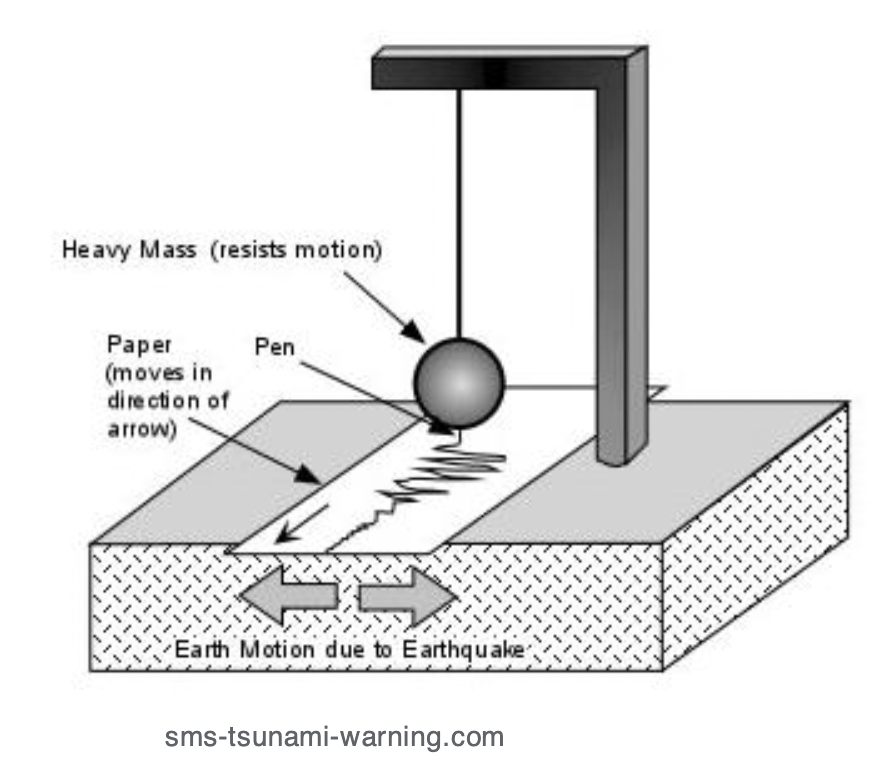
When an earthquake happens, the ground shakes, shaking the support arm and the wire; the suspended weight remains motionless (inertia)
If a marking device (eg. a pen) is attached to the weight, the pen also remains motionless
If paper is added to move steadily below the pen, the paper records the movement of the ground
Seismogram: the paper record of ground motion recorded by a seismograph
Seismographs produce direct records of the amount of ground motion, recording amounts of such motion and timing of seismic events
Seismometer: a modern version of the seismograph replacing a pen and paper with an electronic transducer
Ground motion is recorded as a digital signal which can be transmitted by radio to a central office
Can be set up anywhere in the world
Locating Earthquakes
Measurement devices record the arrival of surface, p-, and s-waves
Speed of waves (fastest to slowest):
P-wave
S-wave
Surface wave
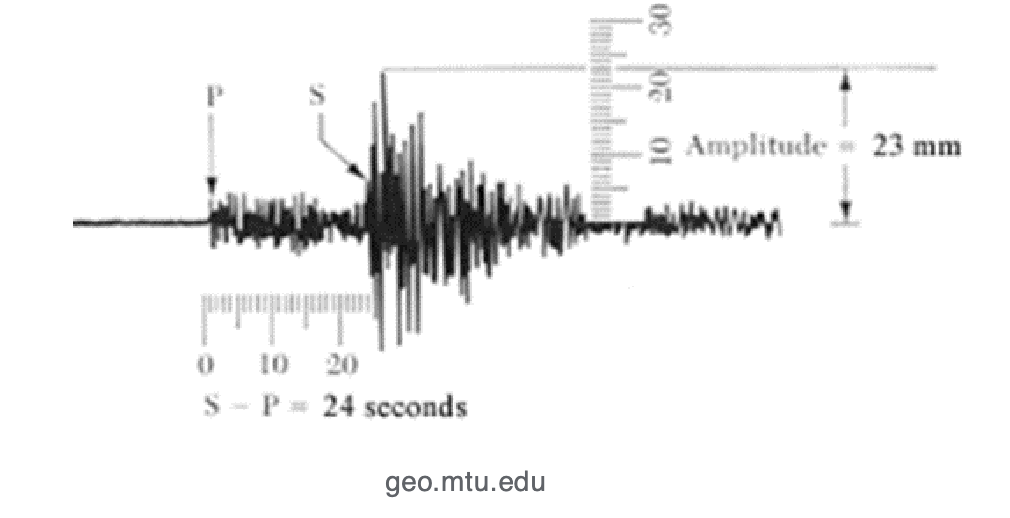
Based on known travel times, the time difference between the p- and s-waves can be used to estimate the distance from the seismometer to the earthquake’s epicenter
This just measures distance, and does not indicate which direction the quake came from
To determine epicenter location, distance measurements are needed from at least three seismic stations to triangulate the center
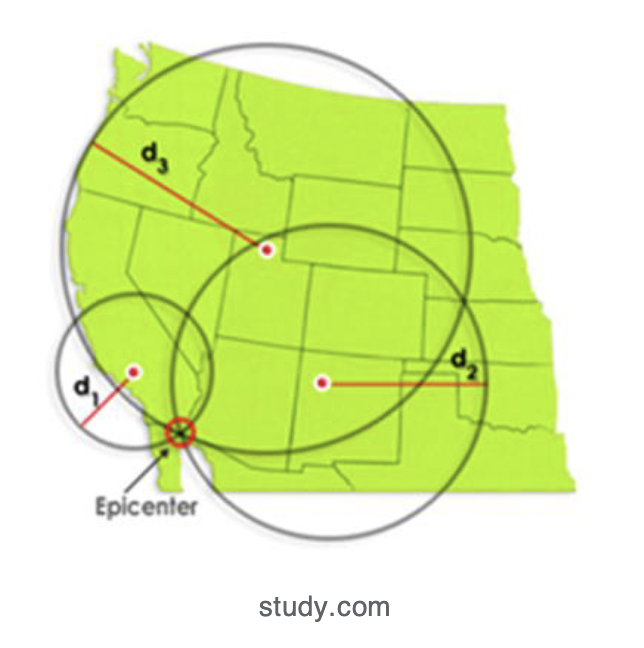
Because the current seismic network is so large, it’s possible to develop three-dimensional information about earthquakes’ locations
The Size and Strength of Earthquakes
Seismic data also provides methods of estimation for earthquake size
The two traditional measurements are intensity and magnitude
Earthquake intensity: the amount of ground motion and force of shaking
Intensity measurements can be estimated from seismic measurements, but are more commonly estimated from damage done by earthquakes
Traditional scale — Mercalli Scale (1-12)
Because of how seismic waves spread from the epicenter, the intensity dissipates farther from the epicenter (modified somewhat by geological characteristics)
Intensity measurements provide useful information about the immediate effects of an earthquake but are not helpful in comparing earthquakes from place to place or time to time
Earthquake magnitude: the amount of energy released when the fault shift releases the built-up pressure that had been stored in the rocks
Not possible to directly measure this energy release (fault movements happen far underground)
Estimates the energy release by the indirect evidence of the seismic waves
Richter Scale: the traditional method of measuring magnitude (1-10)
Richter used seismograph records and measured the size of the tracing of ground motion on the seismogram

Connecting the two measurements on the graph yields the magnitude estimate on the middle line
The Richter scale is logarithmic; each step of 1 is a multiple of 10 on the log scale
Eg. an earthquake with a magnitude of 4 is…
10x smaller than a 5
100x smaller than a 6
1,000x smaller than a 7
And so on
Recently, there’s been some dissatisfaction with the Richter scale → large earthquakes tend to cluster close together and are difficult to differentiate
Moment Magnitude Scale: a new magnitude scale just like the Richter scale, but larger earthquakes are more spread out
Measurements are based on:
The amount of displacement along the fault (how much the fault moves)
The size of the fault line
The density of the rocks around the fault line (harder rocks emit energy more efficiently than softer rocks)
The necessary measurements are more complicated but can be estimated from seismic data with modern technology
Earthquakes
Defining Earthquakes
Originate with sudden shifting of rock
When rocks are under significant pressure, and this pressure continues to build until it exceeds the strength of the rocks, they break and shift, releasing the built-up pressure
This released energy travels outward from the point of breakage and travels in a wave-like motion
On the ground surface, the wave of motion is felt as the ground shaking, or an earthquake

This process is also known as elastic rebound
Elastic rebound: when the rocks release pressure, they rebound to their undistorted (though now broken) condition
The breaking and shifting of rocks results in the creation of faults
Fault: a crack in the rocks along which there has been some kind of movement of the rocks
A crack is only a fault of the rocks have shifted along the fault
Faults may shift vertically or horizontally
The continuous vertical shifting of rocks along faults can produce significant mountain ranges
Eg. the Teton Mountains of Wyoming
Every movement of rocks along a fault produces an earthquake; bigger shifts tend to produce bigger earthquakes
Most earthquakes originate from fault shifts; most fault shifts occur underground
The point where the fault moves (the point from which the earthquake originates) is called the focus
The point on the ground surface, directly above the focus, is called the epicenter
This is marked on most maps as the geographic location of earthquakes

The energy originates from the focus and travels outward in all directions with wavelike motions
Seismic waves: the waves of energy traveling through the surrounding rocks
There are multiple kinds of seismic waves
Surface wave: a seismic wave that travels on the ground surface
Sometimes have visible vertical movements in intense earthquakes

Body wave: a seismic wave that travels through the earth
Two main types of body waves are p- and s-waves (primary and secondary)
P-wave: a body wave that travels by compressing and stretching the rocks in a push/pull motion

S-wave: a body wave that travels through a shaking motion (vertical or horizontal)

P-waves travel faster than s-waves
Earthquakes may also result from the movement of magma rising under a volcano
Rocks shift, having been deformed by the rising magma and release built-up energy
Measuring Earthquakes
Seismology: the study of earthquakes
Seismologist: a geologist who studies earthquakes
Seismograph: a device used to measure the intensity of earthquakes
A simple scientific device based on physics (specifically the principle of inertia)

When an earthquake happens, the ground shakes, shaking the support arm and the wire; the suspended weight remains motionless (inertia)
If a marking device (eg. a pen) is attached to the weight, the pen also remains motionless
If paper is added to move steadily below the pen, the paper records the movement of the ground
Seismogram: the paper record of ground motion recorded by a seismograph
Seismographs produce direct records of the amount of ground motion, recording amounts of such motion and timing of seismic events
Seismometer: a modern version of the seismograph replacing a pen and paper with an electronic transducer
Ground motion is recorded as a digital signal which can be transmitted by radio to a central office
Can be set up anywhere in the world
Locating Earthquakes
Measurement devices record the arrival of surface, p-, and s-waves
Speed of waves (fastest to slowest):
P-wave
S-wave
Surface wave

Based on known travel times, the time difference between the p- and s-waves can be used to estimate the distance from the seismometer to the earthquake’s epicenter
This just measures distance, and does not indicate which direction the quake came from
To determine epicenter location, distance measurements are needed from at least three seismic stations to triangulate the center

Because the current seismic network is so large, it’s possible to develop three-dimensional information about earthquakes’ locations
The Size and Strength of Earthquakes
Seismic data also provides methods of estimation for earthquake size
The two traditional measurements are intensity and magnitude
Earthquake intensity: the amount of ground motion and force of shaking
Intensity measurements can be estimated from seismic measurements, but are more commonly estimated from damage done by earthquakes
Traditional scale — Mercalli Scale (1-12)
Because of how seismic waves spread from the epicenter, the intensity dissipates farther from the epicenter (modified somewhat by geological characteristics)
Intensity measurements provide useful information about the immediate effects of an earthquake but are not helpful in comparing earthquakes from place to place or time to time
Earthquake magnitude: the amount of energy released when the fault shift releases the built-up pressure that had been stored in the rocks
Not possible to directly measure this energy release (fault movements happen far underground)
Estimates the energy release by the indirect evidence of the seismic waves
Richter Scale: the traditional method of measuring magnitude (1-10)
Richter used seismograph records and measured the size of the tracing of ground motion on the seismogram

Connecting the two measurements on the graph yields the magnitude estimate on the middle line
The Richter scale is logarithmic; each step of 1 is a multiple of 10 on the log scale
Eg. an earthquake with a magnitude of 4 is…
10x smaller than a 5
100x smaller than a 6
1,000x smaller than a 7
And so on
Recently, there’s been some dissatisfaction with the Richter scale → large earthquakes tend to cluster close together and are difficult to differentiate
Moment Magnitude Scale: a new magnitude scale just like the Richter scale, but larger earthquakes are more spread out
Measurements are based on:
The amount of displacement along the fault (how much the fault moves)
The size of the fault line
The density of the rocks around the fault line (harder rocks emit energy more efficiently than softer rocks)
The necessary measurements are more complicated but can be estimated from seismic data with modern technology
 Knowt
Knowt
